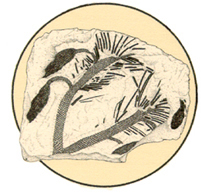 The paleobotanical collection was established and largely built by emeritus Prof. Henry N. Andrews in 1964 when he joined the faculty as Head of the Botany Department. Henry Andrews was a faculty member at the University of Connecticut from 1964 to 1975. Widely considered one of the most prominent figures in the field of paleobotany, he had written several seminal texts in the discipline and was one of the first to emphasize the study of coal ball peels. To this day, he is the only UConn faculty to have been a member of the National Academy of Science. As an intrepid explorer, brilliant scientist, and a leader in his field, Andrews represents the best in UConn’s academic culture and history. For a full biography on Andrews, visit here
The paleobotanical collection was established and largely built by emeritus Prof. Henry N. Andrews in 1964 when he joined the faculty as Head of the Botany Department. Henry Andrews was a faculty member at the University of Connecticut from 1964 to 1975. Widely considered one of the most prominent figures in the field of paleobotany, he had written several seminal texts in the discipline and was one of the first to emphasize the study of coal ball peels. To this day, he is the only UConn faculty to have been a member of the National Academy of Science. As an intrepid explorer, brilliant scientist, and a leader in his field, Andrews represents the best in UConn’s academic culture and history. For a full biography on Andrews, visit here
In addition to the material that Andrews brought and added, the collection grew through additions made by his successor, Dr. William Crepet, and his students. Rock specimens are primarily impressions and compressions. Glass slides bear preparations of coal ball peels, ground thin sections of permineralized plant remains, and spores and cuticle extracted from fossils.
The collection represents the full span of geological time for which plant fossils are known and includes most major plant groups. The specimens are of high quality, selected to illustrate important features of a given plant taxon or group, or are representative taxa of well-known locality, and in some cases represent type or figured specimens (e.g., isotypes of plants from the Early Devonian of the Trout Valley Formation, Maine). Although the holdings are especially rich in Devonian plants, they also include extremely fine specimens of younger (Mesozoic and Cenozoic) plant fossils as well. Many of the coal ball peels are part of a series from which important early coal ball studies, published by Andrews and his students, were made.
- List of paleobotanical slides associated with the works of Henry Andrews.
- List of macrofossil specimens
Curator: Dr. Karolina Heyduk
Collection manager: Dr. Sarah Taylor